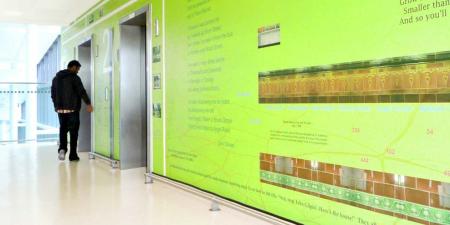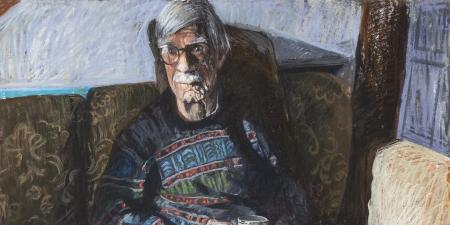Abstract
While there is evidence of the benefits of music for health and wellness, current US clinical practice does not commonly incorporate arts-based interventions, one drawback of which appears to be limited communication among practitioners within the arts, sciences, and health professions fields. This article shares a story of a 2-year multidisciplinary music in medicine program that aims to inspire joy and connection among people with dementia through interactive, creative musical experiences. The authors discuss the program from conception to pilot, canvass adaptations made to adhere to COVID-19 protocols, illuminate common themes of flexibility and curiosity, and share cross-campus, multidisciplinary collaboration experiences that guided the work.
Benefits of Music
Research demonstrates that participatory arts can enhance older adults’ mood, enjoyment, memory, and overall well-being.1,2,3 Music making inherently builds community, serves as an emotional and social outlet, and provides a space for creative expression. Unlike recorded music, live interactive music provides auditory, visual, and tactile-kinesthetic stimulation. More specifically, the sensory stimulation from music making has been shown to improve overall mood and sense of well-being in people with dementia (PWD).4,5 Dowlen et al have shown that participatory music has 4 key benefits for PWD: taking part, being connected, affirming identity, and immersion “in the moment.”6 Informed by application of Dowlen et al’s research and models throughout the United Kingdom, Europe, and the United States,7,8,9,10,11,12,13,14,15,16,17,18 the music in medicine program, Nebraska HeartBeats, at the University of Nebraska Medical Center (UNMC), founded in 2019, provides participant-centered, collaborative music interventions that inspire joy, reminiscing, and memory sharing through music making. In what follows, we present our motivation for developing this program as well as our experience in piloting the program with nursing home residents during the COVID-19 pandemic.
Program Planning
The Nebraska HeartBeats program curriculum at UNMC was developed by the Nebraska HeartBeats team—a group of experts from the fields of music, neuroscience, geriatric psychiatry, dementia care, and music therapy—who teach, provide care, and conduct research. The program was later piloted at a regional memory care facility. The team selected musical genres and songs based on research that demonstrates that the musical memory of PWD remains relatively unaffected at all stages of dementia and that remote memories are more easily accessed by PWD than recent memories.19 In this way, a beloved song from a person’s youth can transport a person to a familiar place, eliciting happy or comforting thoughts. Musical selections, arranged for string quartet, were chosen to reflect popular music from the 1950s to the 1980s, or music that PWD would have enjoyed in their 20s or 30s.
Curricular goals for participants include making music in a variety of ways, engaging in meaningful ways with each other through musical collaboration, reminiscing, and sharing memories. The flexible in-person curriculum is adapted based on participant dementia stage (eg, mild, moderate, or severe) and offers music participation options that range from passive listening to active engagement, including music making with hand-held percussion instruments, improvisation, composition, singing, call and response, and dancing. The program thus provides a variety of engagement opportunities for PWD, many of whom experience a loss of confidence in themselves and their abilities as their disease progresses.
Modifications to the Program During COVID-19
Due to COVID-19, the in-person pilot scheduled for fall 2020 was postponed, and the Nebraska HeartBeats team, of which we are a part, felt a heightened sense of urgency to provide PWD with programming that adhered to COVID-19 protocols recommended by the Centers for Disease Control and Prevention that included social distancing. During this time, PWD were negatively impacted by public health measures meant to protect them and experienced a loss of human connection and everyday social rhythms,20 which may have accelerated their mental and physical decline. According to the Alzheimer’s Association, there were an estimated 42 000 more deaths from Alzheimer’s disease and related dementias in 2020 compared with the 5-year average from 2015 to 2019, representing a 16% increase in deaths attributable to Alzheimer’s disease and related dementias in 2020.21 Given the disproportionate and dangerous impact the COVID-19 pandemic was having on this vulnerable population, we worked to provide virtual programming that includes stimulation, engagement, connection, and socialization.
In spring 2021, the team modified the program to comply with COVID-19 protocols and implemented a virtual pilot with the following goals:
- Improve the quality of life of PWD by providing a safe, supportive space to engage emotionally, socially, and musically.
- Contribute to research on music and dementia care by adding to the literature on why music has a positive effect on the well-being of PWD.6 Additionally, little research exists on the efficacy of virtual music interventions.22,23
- Develop a best-practice model for musicians, arts organizations, and educational institutions to implement their own music in medicine programming.
Pilot
Team members who are part of the University of Nebraska at Omaha Maverick Quartet used televisual technology (ie, Zoom), unmuted with video on, with 10 residents from a memory care facility. Participants, assisted by staff, remained muted but participated by watching and listening to the Zoom session of the quartet. Each of the 6, 30-minute sessions began with quartet introductions followed by instrument introductions for participants (all of whom have an instrument pack with 6 unique instruments). Next, quartet members took turns guiding participants through 5 unique song cycles that included a song introduction, instrument demonstration, instrument modeling, participant instrument practice, and a performance of the song by the quartet while participants listened and took part with percussion instruments.
Music is an important aspect of cultural experience as well as of every person’s unique life story.
Seeking to understand the effects of loneliness and agitation among participants who engaged virtually in the program, we used the following for baseline measurements: the UCLA Loneliness Scale,24 the Cohen-Mansfield Agitation Inventory,25 the Montreal Cognitive Assessment,26 and the Delis Kaplan Executive Function System Verbal Fluency Test.27 The outcome of the interventions was assessed using the Observed Emotion Rating Scale.28 Preliminary findings indicated that delivery of the music program was feasible for memory care residents. Residents were able to participate in the musical intervention delivered virtually, although there were challenges.
During the past 2 years, we faced and overcame challenges, including a lack of support staff, communication lapses, and limited campus infrastructure to facilitate and nurture cross-campus collaboration. Cross-campus collaboration would not have been possible without mentorship support and funding. Additionally, collaboration enabled us to gain valuable insight and knowledge about disciplines outside our areas of expertise. Currently, we seek funds to support continued virtual programing.
Authors’ Perspectives
MARY PERKINSON: As an artist, I’ve worked in the arts and health field for over a decade and care deeply about artist citizenry, or moving beyond the concert stage to contribute to human well-being and flourishing through reflective, empathetic, and intentional engagement with community partners.29,30 This program allows us team members to contribute in meaningful, informed, and collaborative ways during a frightening and uncertain time while leveraging our expertise to contribute to research we could not pursue on our own. Mutual curiosity and flexibility contribute to the success of this collaboration.
VAISHALI PHATAK: Prescription of empirically validated treatments for conditions such as memory disorders, depression, or anxiety is the cornerstone of medical practice to protect individuals from ineffective care. Unfortunately, the current state of medicine still leaves PWD and their families facing an increased social cost. In the face of increased risk of social isolation and caregiver burden, there is an opportunity to bridge the gap by combining arts and science. Music is an important aspect of cultural experience as well as of every person’s unique life story. Offering patients and families not just “traditional” medical prescriptions but the therapeutic benefits of music via research is an opportunity to provide greater personalized care.
MEGHAN RAMIREZ: Growing up in a home where music was ever present, it was heartbreaking for my family to know that my sister, who was born deaf, would never know music the way my family did. During one of my sister’s school concerts, however, I learned to experience music in a new way. Before the concert began, hearing people were given ear plugs and informed that there would be loud music. My sister proceeded to sign the lyrics to Fight Song by Rachel Platten and did not miss a single word because she could feel the music. The therapeutic benefits of music became clear to me growing up with a sister who is deaf. As a first year PhD student in neuroscience, I was excited to be a part of a program that brings neuroscience research and music together and seeks to share the therapeutic benefits of music with an underserved population.
Conclusion
From conception to pilot, the Nebraska HeartBeats team worked collaboratively to complete a successful multidisciplinary research study. We gained new skills and knowledge outside our respective disciplines and engaged in a symbiotic relationship of give and take, listen and learn. Additionally, the team adapted to pandemic restrictions to create a pilot that adhered to COVID-19 protocols. In sum, we leveraged our cross-campus expertise to contribute in meaningful ways to the lives of PWD during a critical time.
References
- Fraser H, Bungay H, Munn-Giddings C. The value of the use of participatory arts activities in residential care settings to enhance the well-being and quality of life of older people: a rapid review of the literature. Arts Health. 2014;6(3):266-278.
-
Vella-Burrows T. Carers Create 2015-2017: report of activities and evaluation of effect. Canterbury Christ Church University; 2017. Accessed August 1, 2021. https://www.artshealthresources.org.uk/docs/carers-create-2015-2017-report-on-activities-and-evaluation-of-effect/
- Redmond M, Sumner RC, Crone DM, Hughes S. “Light in dark places”: exploring qualitative data from a longitudinal study using creative arts as a form of social prescribing. Arts Health. 2019;11(3):232-245.
- Sung HC, Lee WL, Li TL, Watson R. A group music intervention using percussion instruments with familiar music to reduce anxiety and agitation of institutionalized older adults with dementia. Int J Geriatr Psychiatry. 2012;27(6):621-627.
- Osman SE, Tischler V, Schneider J. “Singing for the brain”: a qualitative study exploring the health and well-being benefits of singing for people with dementia and their careers. Dementia. 2016;15(6):1326-1339.
- Dowlen R, Keady J, Milligan C, et al. The personal benefits of musicking for people living with dementia: a thematic synthesis of the qualitative literature. Arts Health. 2018;10(3):197-212.
-
Arts Council of Wales. Arts and Health in Wales: A Mapping Study of Current Activity. Volume 1: Analysis, Findings and Proposals. Arts Council of Wales; 2018. Accessed March 25, 2022. https://www.artshealthresources.org.uk/wp-content/uploads/2018/03/2018-Arts_and_Health_Wales_Volume_1.pdf
- Broome E, Dening T, Schneider J. Facilitating Imagine Arts in residential care homes: the artists' perspectives. Arts Health. 2019;11(1):54-66.
-
Brotherhood E, Ball P, Camic PM, et al. Preparatory planning framework for Created Out of Mind: shaping perceptions of dementia through art and science. Wellcome Open Res. 2017;2:108.
-
Daykin N, Walters D, Ball K, et al. Arts and dementia: using participatory music making to improve acute dementia care in hospital environments: an exploratory study. University of Winchester; 2016. Accessed May 19, 2022. https://www.artshealthresources.org.uk/wp-content/uploads/2018/02/2016-Arts-and-Dementia-fullreport.pdf
-
Franklin Gould V. Music reawakening: musicianship and access for dementia, the way forward. Arts 4 Dementia; 2015. Accessed May 19, 2022. https://www.artshealthresources.org.uk/wp-content/uploads/2017/01/2015-Franklin-Gould-Music-reawakening-Musicianship-and-access-for-dementia.pdf
-
Franklin Gould V. Reawakening the Mind: Evaluation of Arts 4 Dementia's London Arts Challenge in 2012: Arts Interventions to Re-energize and Inspire People in the Early Stages of Dementia and Their Careers. Arts 4 Dementia; 2013. Accessed May 19, 2022. https://www.artshealthresources.org.uk/wp-content/uploads/2018/01/2013-Reawakening_the_Mind_A4D.pdf
-
Coulter A, Tregale L. Final report for Music for a While. 2016.
-
Puch K, Mathew N. Creative Minds in Medicine: A Cleveland Creative Intersection. Community Partnership for Arts and Culture; 2014. Accessed August 2, 2021. https://www.artshealthresources.org.uk/wp-content/uploads/2018/04/2014-Creative-Minds-in-Medicine.pdf
-
Nicholson C, Rodio L, Wilson M. STROKESTRA: Stroke Rehabilitation Through Creative Music-Making Pilot Programme Report. Royal Philharmonic Orchestra; 2016. Accessed July 15, 2021. https://www.artshealthresources.org.uk/wp-content/uploads/2018/10/2016-STROKESTRA-Pilot-Programme-Evaluation-RPO.pdf
-
Heesbeen A, Dröes RM, Hendriks I, Koelewijn J, Meiland F. Unforgettable: How to Make Art and Culture Accessible to People With Dementia and Their Loved Ones. Stedelijk Museum Amsterdam; Van Abbemuseum; VU Medical Center: 2017. Accessed July 1, 2021. https://www.onvergetelijkmuseum.nl/wp-content/uploads/2018/02/EN-Onvergetelijkmuseum-PDF.pdf
- Zeilig H, West J, van der Byl Williams M. Co-creativity: possibilities for using the arts with people with a dementia. Qual Ageing. 2018;19(2):135-145.
-
HeartStrings®. Madison Symphony Orchestra. Accessed June 1, 2021. https://madisonsymphony.org/education-community/heartstrings/
- Jacobsen JH, Stelzer J, Fritz TH, Chételat G, La Joie R, Turner R. Why musical memory can be preserved in advanced Alzheimer's disease. Brain. 2015;138(pt 8):2438-2450.
- Brown EE, Kumar S, Rajji TK, Pollock BG, Mulsant BH. Anticipating and mitigating the impact of the COVID-19 pandemic on Alzheimer's disease and related dementias. Am J Geriatr Psychiatry. 2020;28(7):712-721.
-
New Alzheimer's Association report examines racial and ethnic attitudes on Alzheimer's and dementia care. Alzheimer's Association. March 2, 2021. Accessed May 19, 2022. https://www.alz.org/news/2021/new-alzheimers-association-report-examines-racial
- Vaudreuil R, Langston DG, Magee WL, Betts D, Kass S, Levy C. Implementing music therapy through telehealth: considerations for military populations. Disabil Rehabil Assist Technol. 2022;17(2):201-210.
-
Creech A. Using music technology creatively to enrich later life: a literature review. Front Psychol. 2019;10(117):117.
- Hays RD, DiMatteo MR. A short-form measure of loneliness. J Pers Assess. 1987;51(1):69-81.
- Werner P, Cohen-Mansfield J, Koroknay V, Braun J. The impact of a restraint-reduction program on nursing home residents. Geriatr Nurs. 1994;15(3):142-146.
- Nasreddine ZS, Phillips NA, Bédirian V, et al. The Montreal Cognitive Assessment, MoCA: a brief screening tool for mild cognitive impairment. J Am Geriatr Soc. 2005;53(4):695-699.
-
Delis DC, Kaplan E, Kramer JH. Delis-Kaplan Executive Function System (D-KEFS). Psychological Corporation; 2001.
- Lawton M, Van Haitsma K, Klapper J. Observed affect and quality of life in dementia: further affirmations and problems. J Ment Health Aging. 1999;5(1):69-81.
-
Citizen Artists. Aspen Institute. 2022. Accessed January 2022. https://www.aspeninstitute.org/programs/artsprogram/citizen-artists/
-
Elliott D. Music education as/for artistic citizenship. Music Educators J. 2012;99:21-27.



